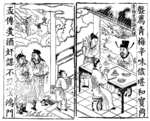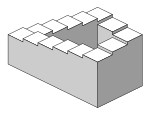使用者:Shinli256/translate
等角圖:英文版

等角圖是在工程製圖中,一種在平面上表達立體圖形的方式。在等角圖中,直角座標系的三條軸被等比例地縮小(意即在圖上的長度相同),且在圖上兩兩夾120度角。
概要
[編輯]爲了達到前面所說等角、等長的特點,等角圖的本質是特定角度的正投影。而這個特定角度就是(±1,±1,±1)的向量(扣除平行而反向的向量有4種可能),或者可以說是:原本是正對著某一面的正投影,先繞z軸旋轉45°(方向不拘),再向上或向下[註 1]旋轉約35.264°[註 2]
Note that with the cube (see image) the perimeter of the 2D drawing is斜體文字 a perfect regular hexagon: all the black lines are of equal length and all the cube's faces are the same area.
In a similar way an isometric view can be obtained for example in a 3D scene editor. Starting with the camera aligned parallel to the floor and aligned to the coordinate axes, it is first rotated downwards around the horizontal axes by about 35.264° as above, and then rotated ±45° around the vertical axis.
Another way in which isometric projection can be visualized is by considering a view within a cubical room starting in an upper corner and looking towards the opposite, lower corner. The x-axis extends diagonally down and right, the y-axis extends diagonally down and left, and the z-axis is straight up. Depth is also shown by height on the image. Lines drawn along the axes are at 120° to one another.
The term "isometric" is often mistakenly used to refer to axonometric projections in general. (There are three types of axonometric projections: isometric, dimetric and trimetric.)
數學關係
[編輯]There are eight different orientations to obtain an isometric view, depending into which octant the viewer looks. The isometric transform from a point in 3D space to a point in 2D space looking into the first octant can be written mathematically with rotation matrices as:
where and . As explained above, this is a rotation around the vertical (here y) axis by , followed by a rotation around the horizontal (here x) axis by . This is then followed by an orthographic projection to the x-y plane:
The other seven possibilities are obtained by either rotating to the opposite sides or not, and then inverting the view direction or not.[1]
歷史與使用的限制
[編輯]First formalized by Professor William Farish (1759–1837), the concept of an isometric had existed in a rough empirical form for centuries.[3][4] From the middle of the 19th century isometry became an "inv斜體文字aluable tool for engineers, and soon thereafter axonometry and isometry were incorporated in the curriculum of architectural training courses in Europe and the U.S."[5] According to Jan Krikke (2000)[6] however, "axonometry originated in China. Its function in Chinese art was similar to linear perspective in European art. Axonometry, and the pictorial grammar that goes with it, has taken on a new significance with the advent of visual computing".[6]
一如所有形式的正投影圖,圖中的物體不能透過大小表現出遠近關係。等角圖滿足了工程製圖所要求,能夠準確地表現物體的尺寸,卻造成失真。相較於正投影圖,透視圖要更接近肉眼、照相機。右邊的兩張圖片則是利用距離難以分辨畫出的圖片。
註解
[編輯]參考資料
[編輯]- ^ Ingrid Carlbom, Joseph Paciorek. Planar Geometric Projections and Viewing Transformations. ACM Computing Surveys (ACM). 1978, 10 (4): 465–502. doi:10.1145/356744.356750. 已忽略未知參數
|month=(建議使用|date=) (幫助) - ^ William Farish (1822) "On Isometrical Perspective". In: Cambridge Philosophical Transactions. 1 (1822).
- ^ Barclay G. Jones (1986). Protecting historic architecture and museum collections from natural disasters. University of Michigan. ISBN 0409900354. p.243.
- ^ Charles Edmund Moorhouse (1974). Visual messages: graphic communication for senior students.
- ^ J. Krikke (1996). "A Chinese perspective for cyberspace?". In: International Institute for Asian Studies Newsletter, 9, Summer 1996.
- ^ 6.0 6.1 Jan Krikke (2000). "Axonometry: a matter of perspective". In: Computer Graphics and Applications, IEEE Jul/Aug 2000. Vol 20 (4), pp. 7–11.
















